15 Nuts and Seeds High in Potassium
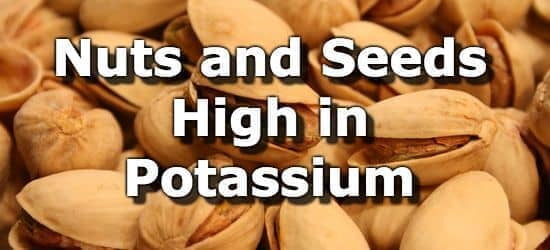
Potassium is an essential nutrient necessary for cell signaling and electrolyte balance in all living things. (1) Since potassium is so universally needed it is often found concentrated in plant foods.
Nuts and seeds typically do not have as much potassium as fruits and vegetables but can still be a good source.
High potassium nuts and seeds include coconut water, hemp seeds, sunflower seeds, pistachios, squash seeds, flax seeds, hazelnuts, almonds, Brazil nuts, and watermelon seeds. The current daily value (DV) for potassium is 4700mg. (2)
See the list below for details on the 15 nuts and seeds with the most potassium. For more information, see the list of high potassium foods.
High Potassium Nuts and Seeds
-
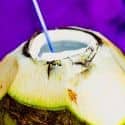 1. Coconut Water + Add
1. Coconut Water + Add
Potassium
per CupPotassium
per 100gPotassium
per 200 Calories600mg
(13% DV)250mg
(5% DV)2632mg
(56% DV)- 11% DV per cup of coconut milk
-
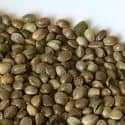 2. Hemp Seeds + Add
2. Hemp Seeds + Add
Potassium
per OzPotassium
per 100gPotassium
per 200 Calories341mg
(7% DV)1200mg
(26% DV)434mg
(9% DV) -
 3. Pistachios (Dry Roasted) + Add
3. Pistachios (Dry Roasted) + Add
Potassium
per 1 Oz HandfulPotassium
per 100gPotassium
per 200 Calories286mg
(6% DV)1007mg
(21% DV)352mg
(7% DV) -
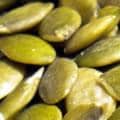 4. Squash and Pumpkin Seeds + Add
4. Squash and Pumpkin Seeds + Add
Potassium
per 1 Oz HandfulPotassium
per 100gPotassium
per 200 Calories261mg
(6% DV)919mg
(20% DV)412mg
(9% DV) -
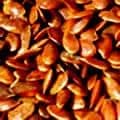 5. Flax Seeds + Add
5. Flax Seeds + Add
Potassium
per OzPotassium
per 100gPotassium
per 200 Calories231mg
(5% DV)813mg
(17% DV)304mg
(6% DV) -
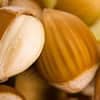 6. Hazelnuts (Filberts) (Dry Roasted) + Add
6. Hazelnuts (Filberts) (Dry Roasted) + Add
Potassium
per 1 Oz HandfulPotassium
per 100gPotassium
per 200 Calories214mg
(5% DV)755mg
(16% DV)234mg
(5% DV) -
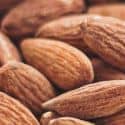 7. Almonds + Add
7. Almonds + Add
Potassium
per 1oz HandfulPotassium
per 100gPotassium
per 200 Calories208mg
(4% DV)733mg
(16% DV)253mg
(5% DV) -
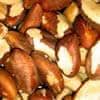 8. Brazil Nuts + Add
8. Brazil Nuts + Add
Potassium
per 1 Oz HandfulPotassium
per 100gPotassium
per 200 Calories187mg
(4% DV)659mg
(14% DV)200mg
(4% DV) -
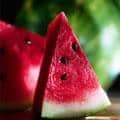 9. Dried Watermelon Seeds + Add
9. Dried Watermelon Seeds + Add
Potassium
per 1oz HandfulPotassium
per 100gPotassium
per 200 Calories184mg
(4% DV)648mg
(14% DV)233mg
(5% DV) -
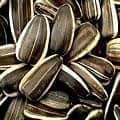 10. Sunflower Seeds + Add
10. Sunflower Seeds + Add
Potassium
per 1 Oz HandfulPotassium
per 100gPotassium
per 200 Calories181mg
(4% DV)645mg
(14% DV)221mg
(5% DV) -
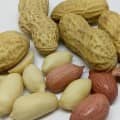 11. Peanuts (Dry Roasted) + Add
11. Peanuts (Dry Roasted) + Add
Potassium
per OzPotassium
per 100gPotassium
per 200 Calories180mg
(4% DV)634mg
(13% DV)216mg
(5% DV)Note: Peanuts are actually a legume but are listed here since they are nuts in the culinary sense.
-
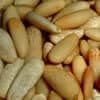 12. Pine Nuts + Add
12. Pine Nuts + Add
Potassium
per 1 Oz HandfulPotassium
per 100gPotassium
per 200 Calories178mg
(4% DV)628mg
(13% DV)200mg
(4% DV) -
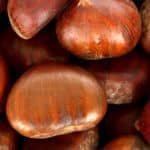 13. Chestnuts + Add
13. Chestnuts + Add
Potassium
per oz(~3 Chestnuts)Potassium
per 100gPotassium
per 200 Calories168mg
(4% DV)592mg
(13% DV)483mg
(10% DV) -
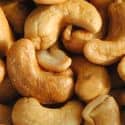 14. Cashews (Dry Roasted) + Add
14. Cashews (Dry Roasted) + Add
Potassium
per 1 Oz HandfulPotassium
per 100gPotassium
per 200 Calories160mg
(3% DV)565mg
(12% DV)197mg
(4% DV) -
 15. Dried Coconut + Add
15. Dried Coconut + Add
Potassium
per OzPotassium
per 100gPotassium
per 200 Calories154mg
(3% DV)543mg
(12% DV)165mg
(4% DV)
How much potassium do you need each day?
The daily value (%DV) for Potassium is 4700mg which is a general target intended for most people. Adequate intakes (%AI) take age and gender into account and range from 2000mg - 3400mg for most people.
| Life Stage | AI | Infants |
|---|---|
| 0-6 months old | 400mg |
| 7-12 months old | 860mg |
| Children | |
| 1-3 years old | 2000mg |
| 4-8 years old | 2300mg |
| Males | |
| 9-13 years old | 2500mg |
| 14-18 years old | 3000mg |
| 19+ years old | 3400mg |
| Females | |
| 9-13 years old | 2300mg |
| 14-18 years old | 2300mg |
| 19+ years old | 2600mg |
| Pregnancy | |
| 14-18 years old | 2600mg |
| 19+ years old | 2900mg |
| Lactation | |
| 14-18 years old | 2500mg |
| 19-30 years old | 2800mg |
From the Nutrient Ranking Tool
Use the ranking tool links below to select foods and create your own food list to share or print.
- Foods High in Potassium
- Foods Low in Potassium
- Vegetables High in Potassium
- Fruits High in Potassium
- Vegetarian Foods High in Potassium
- Nuts High in Potassium
- Grains High in Potassium
- Beans High in Potassium
- Dairy High in Potassium
- Breakfast Cereals High in Potassium
- Fast Foods High in Potassium
View more nutrients with the nutrient ranking tool, or see ratios with the nutrient ratio tool.
Related
Data Sources and References
- Grimm PR, Coleman R, Delpire E, Welling PA. Potassium modulates electrolyte balance and blood pressure through effects on distal cell voltage and chloride J Am Soc Nephrol. 2017 Sep;28(9):2597-2606. doi: 10.1681/ASN.2016090948. Epub 2017 Apr 25. 28442491
- U.S.FDA - Daily Value on the New Nutrition and Supplement Facts Labels
Simplify Nutrition Tracking with MyFoodData!
Speedy Tools and Detailed Data FREEEasily analyze your meals to find the best foods for your goals.
✅ Use our recipe nutrition calculator and nutrition comparison tool.
✅ Access expert nutrition data tools and in-depth articles.
✅ Log foods and organize your recipes with a free account.


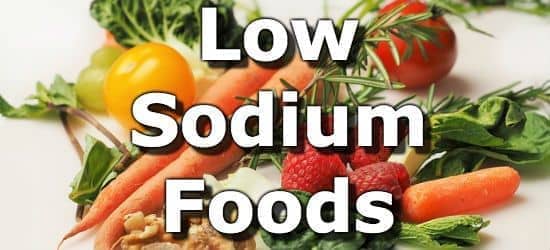 Next ➞
Next ➞
